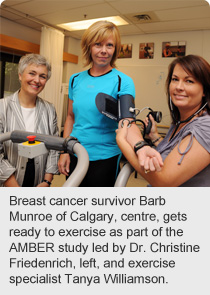
August 29, 2012
Story by James Stevenson; Photo by Paul Rotzinger
Calgarian Barb Munroe felt betrayed by her body when she was diagnosed with breast cancer this past May.
In great shape, healthy and without any family history of the disease, Munroe’s diagnosis was a shock and a blow. But it didn’t last long. She had a mastectomy in June and was out on the golf course three weeks later, swinging away.
“I’m really back to doing everything I was used to doing, and I attribute that to being healthy and having a positive attitude,” says Munroe.
Munroe was the first participant signed up in Calgary for the new Alberta Moving Beyond Breast Cancer, or AMBER, study that is seeking to recruit 1,500 breast cancer patients over the next decade to find out how exercise and fitness affects cancer survival and recovery.
“I really think learning more about the connection between exercise and cancer recovery is something that would be hugely beneficial. So when I saw the poster for the AMBER study, I called right away,” says Munroe.
Funded by the Canadian Institutes for Health Research, the AMBER study will see a multidisciplinary team of researchers from Alberta Health Services (AHS), the University of Alberta, University of Calgary and Athabasca University spend the next 10 to 15 years investigating how breast cancer patients might benefit from exercise and physical fitness.
AHS research scientist and AMBER co-team leader Dr. Christine Friedenreich says the research will provide data on the optimal exercise prescription for improving survival after breast cancer.
“This study is the first cohort study of breast cancer survivors that’s focused specifically on how physical activity and fitness might be associated with the risk of recurrence and survival,” says Friedenreich.
Although some previous research has found that physical activity improves a breast cancer patient’s chances of survival, Friedenreich notes such studies have relied on self-reported data, which is not always reliable. The AMBER study will include objective measures of health-related fitness and physical activity.
Friedenreich, who is also a population-based researcher at the Southern Alberta Cancer Research Institute at the University of Calgary, will lead efforts in Calgary, where her team will recruit newly diagnosed breast cancer patients and assess their physical fitness, activity levels and body composition, in addition to blood and lymphedema tests. Testing will be done soon after surgery and again after one year and three years.
A similar group of patients will be assessed in Edmonton by a team led by Dr. Kerry Courneya, Professor and Canada Research Chair in Physical Activity and Cancer in the University of Alberta’s Faculty of Physical Education and Recreation.
“Right now, we don’t know how much exercise or what type or what pattern might be linked to disease recurrence and survival,” says Courneya, who is also a scientific staff member at AHS – Cancer Care’s Cross Cancer Institute in Edmonton.
Researchers will also look at cancer treatment completion rates, such as whether fit patients are better able to tolerate the toxic side-effects of chemotherapy and hormone therapy treatments, and at biomarkers such as inflammation and insulin levels that might explain how physical activity is related to survival after breast cancer.
They will also examine quality-of-life factors such as depression, anxiety and fatigue, and assess what factors influence survivors to exercise, such as treatments, symptoms and age.
More information on the AMBER study and how to sign up in Edmonton or Calgary can be found at: www.amberstudy.com